Eye on electricity
The impact of La Niña summers on hydro inflows
- Generation
- Wholesale
More than half of New Zealand’s total electricity generation comes from hydro generation, making it an important component of the electricity system. Large hydro generation schemes have storage lakes, where rain and snowmelt inflows can be stored for future hydro generation.
Climate cycles like the El Niño Southern Oscillation (ENSO) tend to impact hydro inflows in New Zealand. The October–December outlook from Earth Sciences New Zealand (formerly NIWA) shows an increased likelihood of La Niña conditions this summer. This article explains how hydro inflows have been impacted during La Niña summers historically.
Hydro generation and New Zealand’s electricity system
Many of New Zealand’s large hydro storage lakes are in the central and southern parts of the South Island while there are also hydro lakes in the North Island, such as Lake Taupō.
The amount of water stored in these lakes fluctuates over time as hydro inflows and generation changes. Storage typically increases in summer and spring due to snowmelt and rainfall exceeding outflows and decreases in autumn and winter. For generators, hydro storage is an important factor in determining how much hydro generation occurs. When hydro storage is low and upcoming conditions are forecast to be dry, hydro generation declines to conserve water.
ENSO is a global climate cycle that influences temperature, wind patterns and rainfall globally, including in New Zealand. ENSO has two phases, El Niño and La Niña, which affect the climate in different ways. El Niño and La Niña periods occur on average every few years and typically last between six and 18 months.
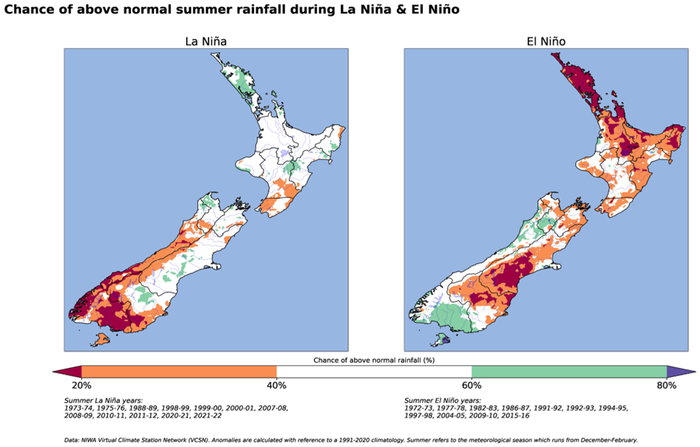
In New Zealand, an El Niño phase typically results in increased westerly winds in summer, bringing less rainfall to eastern areas and more rainfall to the west, as shown in Figure 1. In winter, El Niño leads to more frequent southerlies, leading to cooler temperatures across the country. If El Niño occurs during spring or autumn, south-westerly winds are more frequent.
A La Niña phase tends to increase north-easterly winds. This causes dry conditions in the lower and western South Island and increased rainfall in the east of the North Island (Figure 1). Warmer than average air and sea temperatures can also occur in New Zealand during La Niña.
As Figure 1 shows, La Niña can impact summer rainfall in regions where large South Island hydro storage lakes are located. Figure 2 shows average national hydro inflows for January to May, going back to 1952. Years for which a La Niña summer occurred are highlighted in red.
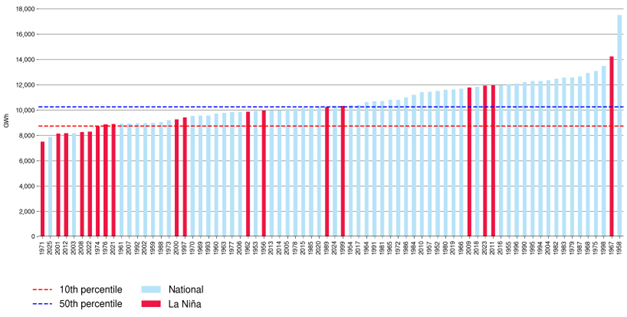
Eight of the 10 lowest average national inflows for January to May occurred during years that experienced a La Niña summer. Outliers, such as 1967, could have been influenced by factors beyond ENSO, such as higher snowmelt.
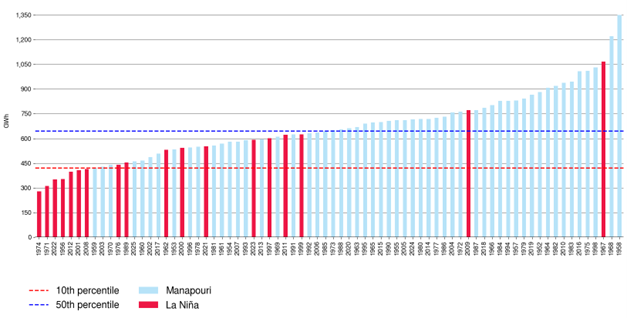
Figure 3 shows historic January to May inflows for Lake Manapōuri, one of the smaller hydro lakes located in Southland, which powers the single largest hydro generator in the country.
The impact of dry La Niña-driven conditions is clear, with 16 of the 18 La Niña summer years being below the 50th percentile of inflows into this lake, and all seven below the 10th percentile being La Niña summers.
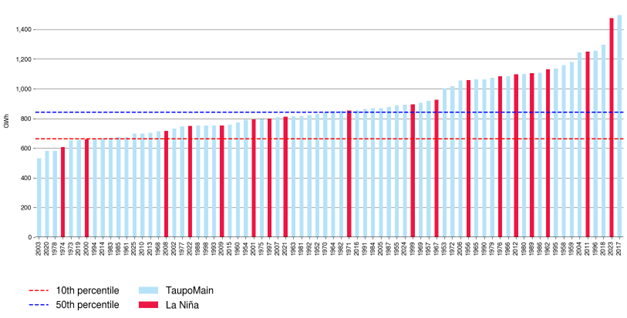
Figure 4 shows the historic January to May inflows for Lake Taupō. As Lake Taupō typically receives normal levels of rainfall during La Niña summers, there is no obvious impact on hydro inflows. Inflow variability between years is likely being driven by other factors aside from by ENSO.
The impact on wholesale prices in 2022
National hydro inflows from January to May 2022 were the ninth lowest in the historic record, following a La Niña summer.
Figure 5 shows that hydro storage declined during January 2022, before continuing to decline even further from mid-February. When these declines in hydro storage occurred, wholesale prices (also Figure 5) increased. These price increases were driven by reductions in hydro generation, with generators choosing to conserve water for future use, resulting in more expensive thermal generation coming online.
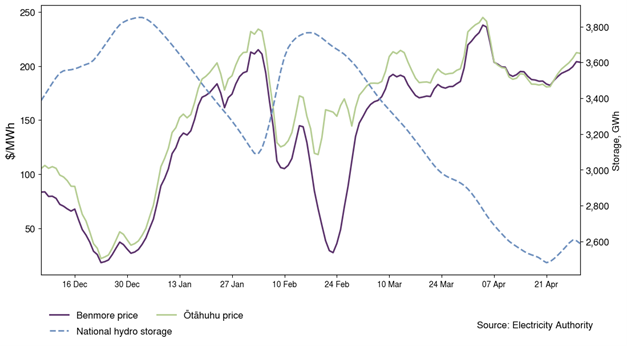
La Niña conditions are possible for the summer
Currently, neither El Niño or La Niña are impacting New Zealand’s weather at the moment. However, according to Earth Sciences New Zealand latest climate outlook, the Southern Hemisphere is trending towards a La Niña phase. This means a La Niña phase may occur during the 2025-26 summer, potentially leading to lower hydro inflows over those months.
If hydro inflows are lower than usual, especially going into winter, storage lakes may be below average when temperatures drop and electricity demand increases. This may lead to higher hydro offer prices and reduced hydro generation. If hydro generation reduces and more thermal generation comes online, this could lead to increased wholesale electricity prices next year.
Ensuring security of supply
The Electricity Authority Te Mana Hiko is focused on ensuring New Zealand has a reliable and continuous electricity supply.
Going into winter 2025, we worked to help industry prepare and to ensure there was enough power in the system to meet the country’s electricity needs. We also have a host of initiatives underway to continually improve market settings to strengthen the security of supply.
We’re monitoring security of supply closely to make sure the electricity system is responding in a way to manage any further tightness in our electricity supply and will continue to provide updates.
One aspect of our monitoring is shown in our weekly trading conduct reports. Here, monitoring of the current participants in the energy market is carried out by the Authority to ensure that prices remain fair and competitive.
Related News
Super-peak hedge contract data collection proposal
We're seeking feedback on a proposal to use clause 2.16 of the Code to formalise the collection of standardised super-peak hedge contract trading information.
Wholesale prices plummet as the proportion of renewables increases
Wholesale electricity prices dropped dramatically in just two months - from over $280/MWh in late August 2025 to an average of $30/MWh in October 2025, the low…
Proposed changes to market making arrangements
The Authority is seeking to strengthen price discovery and confidence in the electricity forward markets by changing market making arrangements.